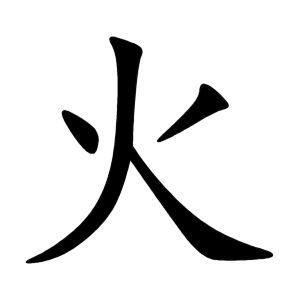火
- fire;
- heat;
Etymology
As an ideogram (pictograph), 火 was created by imitating the shape of fire. It evolved through roughly the following process into its modern form.
Usage in Korean
The standard form of 火 differs slightly between Chinese characters and Korean/Japanese characters:
• In Chinese, the left dot is shaped like a downward right stroke (㇔).
• In Korean and Japanese, it is horizontally mirrored, so the left dot faces the opposite direction.
The stroke order of 灬 (called yeonhwa-bal or "fire dots") is related to the radical 火 (fire). The fire radical has two main forms used as radicals:
The full form 火 (불화변, fire radical)
The variant 灬 (불화부 발, fire dots), which appears at the bottom of many characters.
In the Kangxi Dictionary, the fire radical is the 86th radical. As expected for a radical meaning "fire," it often appears in characters related to fire or heat.
Examples include:
熱 (heat)
灰 (ash)
炭 (charcoal)
燈 (lamp)
爆 (explode)
燃 (burn)
炅 (bright flame)
燒 (to burn)
炎/ 焰 (flame)
炮 (to roast)
焦 (to scorch)
煉 (to refine)
Interestingly, some characters have the fire radical but are not directly related to fire, such as:
然 (so, thus), which originally depicts roasting dog meat over fire as a ritual,
無 (none)
烏 (crow)
熊 (bear)
燕 (swallow)
So, while the fire radical often signals fire-related meaning, there are exceptions.
Alternative forms
Characters with 火
Words that derived from 火
- 火 (F)
- ⿻⿰ 丿 丿 人 (G J K V)
- ⿻ 丷 人 (H T)
